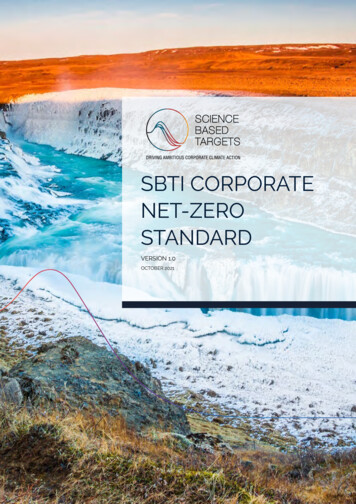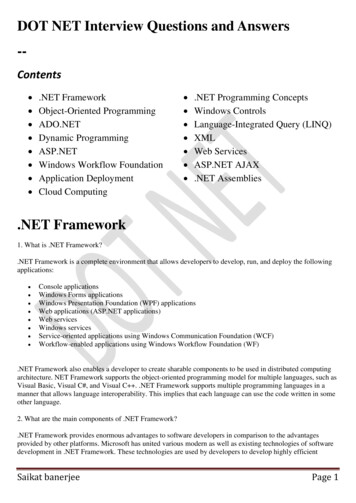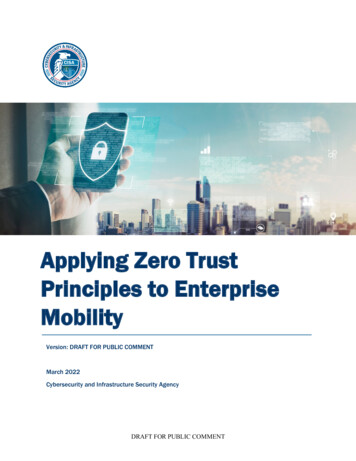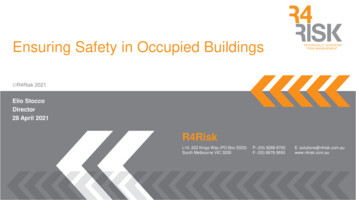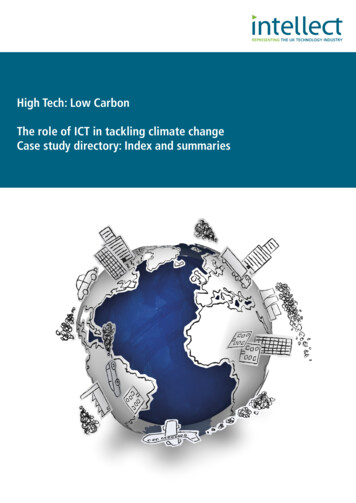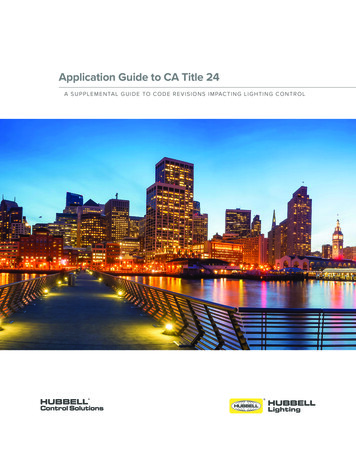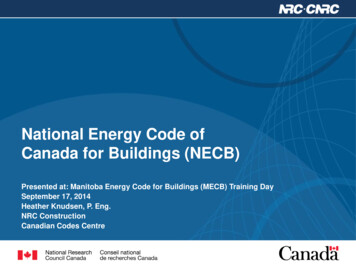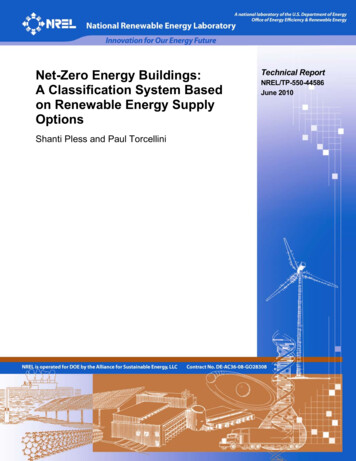
Transcription
Net-Zero Energy Buildings:A Classification System Basedon Renewable Energy SupplyOptionsShanti Pless and Paul TorcelliniTechnical ReportNREL/TP-550-44586June 2010
Net-Zero Energy Buildings:A Classification System Basedon Renewable Energy SupplyOptionsShanti Pless and Paul TorcelliniPrepared under Task Nos. BEC7.1210, BEC7.1123National Renewable Energy Laboratory1617 Cole Boulevard, Golden, Colorado 80401-3393303-275-3000 www.nrel.govNREL is a national laboratory of the U.S. Department of EnergyOffice of Energy Efficiency and Renewable EnergyOperated by the Alliance for Sustainable Energy, LLCContract No. DE-AC36-08-GO28308Technical ReportNREL/TP-550-44586June 2010
NOTICEThis report was prepared as an account of work sponsored by an agency of the United States government.Neither the United States government nor any agency thereof, nor any of their employees, makes anywarranty, express or implied, or assumes any legal liability or responsibility for the accuracy, completeness, orusefulness of any information, apparatus, product, or process disclosed, or represents that its use would notinfringe privately owned rights. Reference herein to any specific commercial product, process, or service bytrade name, trademark, manufacturer, or otherwise does not necessarily constitute or imply its endorsement,recommendation, or favoring by the United States government or any agency thereof. The views andopinions of authors expressed herein do not necessarily state or reflect those of the United Statesgovernment or any agency thereof.Available electronically at http://www.osti.gov/bridgeAvailable for a processing fee to U.S. Department of Energyand its contractors, in paper, from:U.S. Department of EnergyOffice of Scientific and Technical InformationP.O. Box 62Oak Ridge, TN 37831-0062phone: 865.576.8401fax: 865.576.5728email: mailto:reports@adonis.osti.govAvailable for sale to the public, in paper, from:U.S. Department of CommerceNational Technical Information Service5285 Port Royal RoadSpringfield, VA 22161phone: 800.553.6847fax: 703.605.6900email: orders@ntis.fedworld.govonline ordering: http://www.ntis.gov/ordering.htmPrinted on paper containing at least 50% wastepaper, including 20% postconsumer waste
Executive SummaryA net-zero energy building (NZEB) is a residential or commercial building with greatly reducedenergy needs. In such a building, efficiency gains have been made such that the balance ofenergy needs can be supplied with renewable energy technologies. Past work has developed acommon NZEB definition system, consisting of four well-documented definitions, to improvethe understanding of what net-zero energy means. For this paper, we created a classificationsystem for NZEBs based on the renewable sources a building uses. A building that offsets all itsenergy use from renewable resources that are available within the footprint is at the top of theNZEB classification system at an NZEB:A. A building that achieves an NZEB definitionthrough a combination of on-site renenewables and off-site purchases of renewable energycredits is placed at the lowest end of the NZEB classification at an NZEB:D. We also look athow this classification relates to the previously developed NZEB definitions. The goal of thistype of classification is to encourage NZEB owners and NZEB designers to first use all possiblecost-effective energy efficiency strategies, and then use renewable sources and technologies thatare located on the building and at the site. We have provided for lower classes of NZEB toinclude buildings whose energy use exceeds the renewable energy available at the site. ThisNZEB classification system is applicable to both single building projects as well as a set ofbuildings in a community or campus.iii
Acronyms and AbbreviationsNZEBnet-zero energy buildingNZEB:AA footprint renewables NZEBNZEB:BA site renewables NZEBNZEB:CAn imported renewables NZEBNZEB:DAn off-site purchased renewables NZEBPVphotovoltaicRErenewable energyRECrenewable energy creditiv
ContentsExecutive Summary . iiiAcronyms and Abbreviations . ivIntroduction. 1Background . 1Net-Zero Energy Building Concepts and Assumptions. 2Grid Connection. 2Fuel Switching . 2Renewable Energy Credits. 2Energy Supply Options and Priorities. 3Discussion of Supply Options. 4Option 0 – Low-Energy Buildings. 4Option 1 – Renewable Energy Generated Within the Building Footprint. 5Option 2 – Renewable Energy Generated Within the Boundary of the Building Site . 5Option 3 – Off-Site Renewable Energy Used To Generate Energy On Site . 5Option 4 – Purchase Renewable Energy Generated Off Site . 7Net-Zero Energy Buildings: Definitions. 7Near Zero-Energy Buildings. 8Applying a Classification System to Net-Zero Energy Buildings . 8Buildings Classified as NZEB:A. 9Buildings Classified as NZEB:B. 9Buildings Classified as NZEB:C. 9Buildings Classified as NZEB:D. 9Off-Grid Net-Zero Energy Buildings . 11Zero Energy Beyond a Single Building . 11Conclusions. 11References. 14TablesTable 1. NZEB RE Supply Option Hierarchy . 4Table 2. Applying NZEB Definitions. 10FigureFigure 1. NZEB Classification Flow Chart. 13v
IntroductionBuildings have a significant impact on energy use and the environment. Commercial andresidential buildings use almost 40% of the primary energy and approximately 70% of theelectricity in the United States (EIA 2005). The energy used by the building sector continues toincrease, primarily because new buildings are constructed faster than old ones are retired.Electricity consumption in the commercial building sector doubled between 1980 and 2000, andis expected to increase another 50% by 2025 (EIA 2005). Energy consumption in thecommercial building sector will continue to increase until buildings can be designed to useenergy efficiently and produce enough energy to offset the growing energy demand of thesebuildings. Toward this end, the U.S. Department of Energy has established an aggressive goal tocreate the technology and knowledge base for cost-effective net-zero energy commercialbuildings (NZEBs) by 2025.BackgroundIn concept, an NZEB is a building with greatly reduced operational energy needs. In such abuilding, efficiency gains have been made such that the balance of the energy needs can be offsetby renewable technologies. Torcellini et al. (2006) developed an NZEB definition system toimprove the understanding of what zero energy means. They developed four documenteddefinitions—net-zero site energy, net-zero source energy, net-zero energy costs, and net-zeroenergy emissions. Each NZEB definition, corresponding to a different energy use accountingmethod, has merits as a zero energy design goal; however, there is no single best accountingmethod. The NZEB definition used should align with the owner’s goals for the project. Thispaper adds another dimension to the NZEB definitions based on a hierarchy of possiblerenewable energy (RE) supply options for NZEBs.We propose a classification grading system for NZEBs based on the RE sources a building uses.NZEB classifications from NZEB:A to NZEB:D are proposed based on the RE type and locationwith respect to a building. This classification system recognizes that there are many possible REsupply options, depending on the site constraints and locally available renewable options. Wealso look at how this classification applies to the previously developed NZEB accountingmethods. This technical report further documents and details this classification system that wasoriginally summarized by Crawley et al. (2009).Using NZEB design goals takes us out of designing low-energy buildings with a percent energysavings goal and into the realm of a more sustainable energy end point. The goals that are setand how those goals are defined are critical to the design process. The definitions will influencedesigners who strive to meet the goals (Deru and Torcellini 2004). Because design goals are soimportant to achieving high-performance buildings, the way an NZEB goal is defined is crucialto understanding the combination of applicable efficiency measures and RE supply options. ThisNZEB accounting and classification system is applicable to owners developing design goals, toarchitects and engineers tracking the modeled performance of the design, and to operatorsmeasuring the energy use. The NZEB status should be measured, reviewed, and tracked eachyear.1
Net-Zero Energy Building Concepts and AssumptionsGrid ConnectionBefore discussing the RE supply options available to NZEBs, we must look at the issue of gridconnection. Conceptually, an NZEB produces as much as or more energy than it uses annuallyand exports excess RE generation to the utility (electricity grid, district hot water system, orother central energy distribution system) to offset the energy used. For NZEBs, a utilityconnection is allowed for energy balances. A grid-connected NZEB uses traditional energysources such as electricity and natural gas utilities when on-site generation from RE does notmeet the loads. When the on-site generation exceeds the building’s loads, excess energy isexported to the utility. By using the utility to account for the energy balance, excess productioncan offset later energy use.We assume that excess on-site generation can always be sent to the grid to be fully used.However, in high market penetration scenarios, the grid may not always need this energy. In thisscenario (and depending on the electricity utility), on-site energy storage would becomenecessary to maintain the zero energy status of the building.Off-grid NZEBs are also possible under this classification system; however, they typicallyrequire additional on-site generation capabilities combined with significant energy storagetechnologies. Backup energy sources for off-grid NZEBs would also have to be supplied withRE fuels under this classification system.Fuel SwitchingThe NZEB definitions and classifications enable renewable electricity generation to offsetvarious fossil fuel energy uses. For example, natural gas energy use can be offset with excessphotovoltaic (PV) or wind energy exported to the grid; the offset level is determined by theenergy use accounting method. A site energy accounting allows for a 1-to-1 offset betweenfuels; source energy can place an additional offset (approximately 3-to-1) for renewableelectricity exported to the grid. These source-to-site ratios are well documented and varydepending on the utility mix (Deru et al. 2007).Renewable Energy CreditsMany RE projects are partially financed through the sales of renewable energy credits (RECs).Although this is an important financial tool, once the RECs are sold and then purchased bysomeone else, the project cannot claim the benefits of the RE produced on site for the purposesof our NZEB classification. In some utility purchase models, the RECs are not resold; rather,they are retired and used by the utility to meet a renewable portfolio standard obligation. Inthese examples—where a project does not own or retain its RECS—the project’s RE is notavailable as an RE option in the NZEB context. This is to avoid double counting the RECs. Ifthe project buys back an equivalent amount of certified RECs, such as Xcel’s Windsource (Xcel2010) or Green-E certified renewables (Green-E 2009), the project’s on-site RE is available forcredit toward an NZEB position for as long as the project purchases equivalent RECs.2
Energy Supply Options and PrioritiesVarious supply-side RE generation technologies are available for NZEBs (Torcellini et al. 2006).Typical examples of these technologies include PV, solar hot water connected to a district hotwater system, wind, hydroelectricity, and biofuels. Demand-side RE and efficiency measuresinclude strategies that save energy but typically are not commoditized. These cannot be includedin the supply-side balance for achieving an NZEB. Typical examples of demand-side RE andenergy efficiency strategies include passive solar heating, daylighting, solar ventilation airpreheaters, and domestic solar water heaters.Guiding principles for RE in NZEBs were developed to minimize the energy transfers fromgeneration source to end use and provide long-term maintainability in the built environment: Minimize the overall environmental impact by encouraging energy-efficient buildingdesigns, using emissions-free RE, and reducing transportation, transmission, andconversion losses. Will be available over the lifetime of the building. Are highly scalable, widely available, and have high replication potential for futureNZEBs.We developed a hierarchy of RE sources in the NZEB context to reflect these principles. Table 1shows this ranking in order of preferred application.This hierarchy is weighted toward RE technologies that are available within the buildingfootprint and at the site. Rooftop PV and solar water heating are the most applicable supply-sidetechnologies for widespread application of NZEBs. Other supply-side technologies such asparking lot-based wind or PV systems may be available for limited applications. A good NZEBshould first encourage energy efficiency, and then use RE sources that are available within thebuilding footprint—the definitions and classification system support this. However, some highenergy use building types such as hospitals and grocery stores cannot realistically applyefficiency measures to the point where they can offset all energy use with a combination of onbuilding and on-site renewables. Therefore, this NZEB classification system includes off-sitesupply options so all possible building types can potentially reach an NZEB position.This hierarchy was initially discussed by Torcellini et al. (2006). We have since expanded to aformal classification system, added detail to the RE source hierarchy, and modified it toaccommodate specific site details and energy uses. After examining several NZEBs and howpeople use the definitions, we added a discussion to address RE use for campus andneighborhood environments. Table 1 provides a brief overview of each energy supply optionand is followed by a discussion of each.3
Table 1. NZEB RE Supply Option HierarchyOptionNumber0NZEB Supply-Side OptionsExamplesReduce site energy use through energyefficiency and demand-side renewablebuilding technologies.Daylighting; insulation; passive solarheating; high-efficiency heating,ventilation, and air-conditioningequipment; natural ventilation, evaporativecooling; ground-source heat pumps;ocean water coolingOn-Site Supply Options1Use RE sources available within thebuilding footprint and connected to itselectricity or hot/chilled water distributionsystem.PV, solar hot water, and wind located onthe building2Use RE sources available at the buildingsite and connected to its electricity orhot/chilled water distribution system.PV, solar hot water, low-impact hydro, andwind located on parking lots or adjacentopen space, but not physically mounted onthe buildingOff-Site Supply Options34Use RE sources available off site togenerate energy on site and connected tothe building’s electricity or hot/chilled waterdistribution system.Biomass, wood pellets, ethanol, orbiodiesel that can be imported from offsite, or collected from waste streams fromon-site processes that can be used on siteto generate electricity and heatPurchase recently added off-site REsources, as certified from Green-E (2009)or other equivalent REC programs.Continue to purchase the generation fromthis new resource to maintain NZEBstatus.Utility-based wind, PV, emissions credits, orother “green” purchasing options. All off-sitepurchases must be certified as recentlyadded RE. A building could also negotiatewith its power provider to install dedicatedwind turbines or PV panels at a site withgood solar or wind resources off site. In thisapproach, the building might own thehardware and receive credits for the power.The power company or a contractor wouldmaintain the hardware.Discussion of Supply OptionsThis section presents a brief discussion about the various energy supply options listed in Table 1.These options form the basis for the NZEB classification discussed later in this paper.Option 0 – Low-Energy BuildingsOption 0 states that a building must reduce site energy use through demand-side RE and energyefficiency technologies. Option 0 is considered a prerequisite and is an essential andfundamental quality of NZEBs. A well-optimized NZEB design should include energyefficiency strategies to the point that the available RE strategies become more cost effective.Efficiency measures or energy conversion devices such as daylighting or natural gas-firedcombined heat and power devices are not considered to be on-site, supply-side RE production in4
the NZEB context. Any RE source such as passive solar space heating, solar thermal air heaters,ground-source heat pumps, and natural ventilation that cannot be commoditized, exported, andsold, are considered to be demand-side technologies and efficiency measures. Combined heatand power systems that use fossil fuels to generate heat and electricity are considered to bedemand-side technologies.Option 1 – Renewable Energy Generated Within the Building FootprintThis option covers all energy generated and used (or exported) from RE sources collected withinthe building footprint. Option 1 renewables apply only to a single building and to the REconnected directly into its energy distribution infrastructure. RE that is generated and usedwithin the building footprint is directly connected to the building’s electricity or hot watersystem, which minimizes transmission and distribution losses. This includes RE technologiesmounted on the building roof or façade. Typical Option 1 technologies include PV and solarthermal systems. Building-mounted wind turbines may also have some limited application.Building-mounted RE technologies are preferable because the collection area can be guaranteedto be available over the life of the building. Other permanent structures could includenonbuildable land and parking, and are considered in Option 2. Systems mounted within theboundary of the site, but not on the permanent building structure, could have a greater chance ofbeing shaded, blocked, or removed because of future development needs for adjacent land.Typically, the only area available for on-site energy production that a building has guaranteed as“its own” over its lifetime is within its footprint. To ensure this area is available for on-siteproduction, many states, counties, and cities have solar access ordinances that declare the right touse the natural resource of solar energy as a property right. For example, the City of Boulder,Colorado, has a solar access ordinance that guarantees access to sunlight for homeowners andrenters. This ordinance protects the solar access of existing buildings by limiting the amount ofshadow that new development may cast on neighboring buildings, and maintains the potential forusing RE systems in buildings (City of Boulder 2006). Using a PV system within the boundaryof the building site to generate electricity is less favorable than a roof-mounted PV systembecause the area outside the building’s footprint could be shaded or developed in the future.Thus, it cannot be guaranteed to provide long-term generation.Fuel cells and microturbines that use natural gas do not generate RE and exported energy wouldnot count toward any of these options; rather, they typically transform purchased fossil fuels intoheat and electricity. This can be a valuable source-energy efficiency strategy. Energy thatcannot be used by the building at the time of generation and must be exported is not counted forthe purposes of defining an NZEB.Option 2 – Renewable Energy Generated Within the Boundary of the Building SiteThis option addresses RE generated on the building site but not within its footprint or mountedon the building. On-site RE is ideally connected directly to the building’s electricity, hot/chilledwater, or other building energy systems; however, on-site RE does not necessarily have to bedirectly connected if the RE equipment can be shown to be located on the building’s site using acommonly accepted site definition. One example of such a building site definition (based on 40CFR 260.10) is:The on-site RE must be located on the property, or on property geographicallycontiguous to the property, on which the building is located, except that the two5
properties may be separated by an easement, public thoroughfare, transportation,or utility-owned right-of-way. Non-contiguous properties owned by the sameorganization but connected by a right-of-way which is controlled and to whichthe public does not have access, is also considered on-site property.The site is typically defined as the property boundary; however, sites should represent ameaningful boundary that is functionally part of the building. When using this option, the sitemust be defined and justified.Typical strategies include parking lot PV systems mounted to shading structures, tower-basedwind turbines mounted in a neighboring field, and ground-mounted solar hot water systemsconnected into the building’s hot water distribution system. An on-site solar-thermal absorptionchiller would also be considered under this option. When available, biomass harvested from thesite and used in the building (or exported) is also considered a site RE resource, as long as theresource is renewable over the life of the building.Option 3 – Off-Site Renewable Energy Used To Generate Energy On SiteRE resources from outside the building site boundary (Options 3 and 4 in Table 1) couldarguably also be used to achieve an NZEB. Often, high energy use buildings such as hospitals,laboratories, and grocery stores do not have sufficient RE generation capacity available withinthe building footprints or within the site boundaries. Our NZEB classification recognizes this,and was developed so all buildings could potentially reach NZEB. NZEBs that requiresignificant off-site RE can achieve net-zero energy consumption under this classification system.However, it is not the same as a building that generates all needed energy on site and is classifiedas such.Renewable sources such as wood pellets, ethanol, and biodiesel that are imported to the site canbe valuable, but are less valuable than on-site renewable sources in the NZEB context. Option 3is less preferable than Option 1 or 2 because of the energy used and the carbon footprintassociated with producing and transporting the renewable resource to the building site. Abuilding could qualify as an NZEB by using RE sources that are available off site, importingthem on site, and then using them to generate energy on site. An example of this would be woodchips imported to heat a building. Other off-site renewables covered under this option includewaste vegetable oil, biodiesel, and ethanol. Methane from human and animal waste treatmentprocesses, recovery of waste energy streams from industrial processes, or landfill gas collectionare all possible off-site RE generation options covered under Option 3, if they are available overthe life of the building.Biofuels from these sources can provide valuable RE with less environmental impact than fossilfuels, but are not typically considered emissions free. Understanding and documenting the lifecycle emissions and carbon impacts of biofuels are important steps in including these types ofrenewables in NZEB project. The land needed for Option 3 renewables is also typically muchgreater than for Option 1 or 2.Option 1 and 2 renewables are preferred over Option 3 renewables in the NZEB context, butOption 3 renewables are still preferred over off-site purchases of RECs (Option 4). Thishierarchy values a project that takes some responsibility for generating (or using) its own RE,rather than a simple off-site REC purchase. Option 3 renewables also offer many potential6
benefits of typical distributed generation combined heat and power strategies, and significantlyreduce source energy use and emissions.Option 4 – Purchase or Install Renewable Energy Generated Off SiteThis option addresses purchased RE generated off site that has been certified as a newly installedsource. Typical examples include utility-based wind, RECs, and other “green” credits ascertified by Green-E (2009) or other equivalent rating organizations. For a building to use thisenergy option and be considered an NZEB, the off-site RE generated must be a recently installedand certified RE source. This new grid-based renewable resource must also be available andpurchased for the building to maintain an NZEB status.A variation on this option could be an organization that puts into place strict efficiency goals andnegotiates with its power provider to install off-site dedicated wind turbines or PV panels at alocal or regional off-site location with better solar or wind resources. In this approach, theorganization might finance or own the hardware (or a portion of the system) and receive creditsfor the power. The power company or a contractor would maintain the hardware. The buildingowner would probably also pay a charge to the utility to “transport” this energy. This would be astronger commitment than buying new RECs.A building that purchases all its RE has little incentive to reduce building loads. Through theseavenues, a building could qualify as zero energy even if it directly consumes a large amount ofenergy generated from fossil fuels. The intentions might be good, but this type of building is theleast optimal classification of an NZEB and may not reduce energy consumption overall. TheNZEB classification system responds by valuing this renewable resource at the bottom of theclassification.Net-Zero Energy Buildings: DefinitionsThe energy performance of an NZEB can be accounted for or defined in several ways, dependingon the boundary and the metric. Different definitions may be appropriate, depending on theproject goals and the values of the design team and building owner. As documented anddiscussed by Torcellini et al. (2006), four commonly used accounting methods are net-zero siteenergy, net-zero source energy, net-zero energy costs, and net-zero energy emissions. Eachdefinition uses the grid for net use accounting and has different applicable RE sources. Net-Zero Site Energy: A site NZEB produces at least as much RE as it uses in a year,when accounted for at the site. Net-Zero Source Energy: A source NZEB produces (or purchases) at least as much REas it uses in a year, when accounted for at the source. Source energy refers to the primaryenergy used to extract, process, generate, and deliver the energy to the site. To calculatea building’s total source energy, imported and exported energy is multiplied by theappropriate site-to-source conversion multipliers based on the utility’s source energytype. Net-Zero Energy Costs: In a cost NZEB, the amount of money the utility pays thebuilding owner for the RE the building exports to the grid is at least equal to the amountthe owner pays the utility for the energy services and energy used over the year.7
Net-Zero Emissions: A net-zero emissions building produces (or purchases) enoughemissions-free RE to offset emissions from all energy used in the building annually.Carbon, nitrogen oxides, and sulfur oxides are common emissions that NZEBs offset. Tocalculate a building’s total emissions, imported and exported energy is multiplied by theappropriate emission multipliers based
A net-zero energy building (NZEB) is a residential or commercial building with greatly reduced energy needs. In such a building, efficiency gains have been made such that the balance of . (Green-E 2009), the project’s on-site RE is available for credit toward an NZEB position
